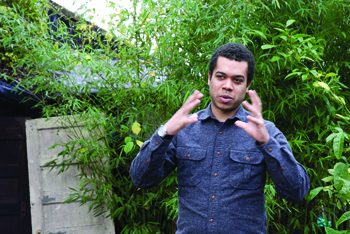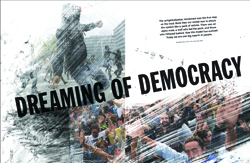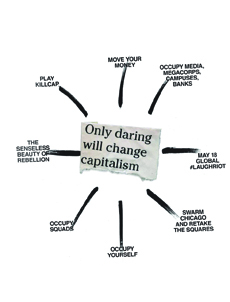The Revolution Will Be Advertised
‘Adbusters’ editor Micah White ’04 helped launch a nationwide protest movement by occupying his readers’ imaginations

Micah White ’04, shortly before he moved from San Francisco, where Occupy Wall Street was hatched. Photo by Seth Affoumado
June 9, 2011, was a typical day for Adbusters, the eye-catching Vancouver, British Columbia-based magazine of radical political activism and social commentary. Kalle Lasn, the 70-year-old founder and editor-in-chief, was trading emails with frequent collaborator Micah White ’04, an editor 40 years his junior. The subject was a planned action in Lower Manhattan to protest financial industry excess. White, in an email, suggested a name: Occupy Wall Street (OWS).
That night, Lasn registered a website with that name. Within a month, local activists in and around New York City were making plans, and three months later, on Sept. 17, the most prominent left-wing American protest movement in a generation was under way. Activists held Zucotti Park for 59 heady days. As countless similar encampments sprang up around the country, the news media could not help but take notice of protesters’ manifold complaints about income inequality, corporate abuses, and elected government’s subordination to the financial industry.
For White, the viral success of his brainchild echoed a similar, if much smaller-scale, protest he’d engineered as a student at Swarthmore. In 2001, White founded Why War?, one of the first anti-war student organizations of the Bush II era, with several friends. In 2003, the group acquired sensitive leaked memos from Diebold, a manufacturer of black-box-style voting machines whose CEO was a prominent Bush supporter. The memos suggested widespread mismanagement and a cover-up of known equipment problems.
White hosted copies of the leaked memos on Swarthmore’s server despite complaints from Diebold, and, after a cease-and-desist letter, from the College itself. “It was kind of an early WikiLeaks thing,” White says. “We embroiled Swarthmore in this legal battle. I don’t think they really appreciated that.”

An example of the edgy designs of Adbusters. Courtesy of Adbusters/adbusters.org
At one point, the school went so far as to switch off the ethernet connection in White’s dorm room. But by then it was too late—White and his collaborators had encouraged copycat student activists to host the same leaked memos on other college and university servers across the country. When U.S. Rep. Dennis Kucinich (D-Ohio) linked to the documents from a congressional server, Diebold’s legal team gave up. Transparency had won the day.
“That was my first realization of how quickly successful campaigns can succeed,” White says. “The entire campaign lasted one month. It was an insane month but—and this was the realization of Occupy, too—when you create an idea that’s easy for people to do themselves, it’s unstoppable.”
Despite his penchant for antagonistic civil disobedience, White speaks fondly of his time at Swarthmore. In class, he soaked up the sort of history and political theory that now permeates his writing for Adbusters, focusing on the question of how to put such ideas into practice outside the ivory tower.
“I’m not surprised at all that Micah was pivotal in the OWS movement,” says Carina Yervasi, the associate professor of French who taught White in a capstone course on interpretation theory. “Of all the students I had, he was usually the one who asked questions of practice for the theory we were reading.”
After graduation, White wrote Lasn an unsolicited letter announcing that he would be in Vancouver and hoped to intern at Adbusters. He omitted the fact that working for the magazine was his sole reason for moving to Vancouver. “It had been my dream job since I was 14,” he says. “Adbusters captured my imagination. It’s so visually rich that you fall into this world, this aesthetic universe, and it starts to color how you perceive things.”
These days, White sees himself as a sort of pied piper, trying to catch the imaginations of a new generation of teenagers. “I’m constantly thinking about how to talk to people who right now are 17, 18, 19 and, like me, are going to find Adbusters in the bookstore and think, ‘Wow, what’s this crazy magazine?’ ” he says.
Despite their pivotal role in developing the concept of Occupy Wall Street, White and Lasn have not gone out of their way to take credit for the protests. “We tried to not position ourselves as leaders,” White says. “We want to be meme warriors. We want to put out ideas. Someone said that the idea is the leader. I think that’s really true.”
After completing his initial internship at Adbusters, White and his now-wife, Chiara Ricciardone ’05, moved to Egypt for nine months. The time spent in and around Cairo helped open White’s eyes to the global struggle for justice—and helped lay the groundwork for Occupy Wall Street.
struggle for justice—and helped lay the groundwork for Occupy Wall Street.
“I would see the disrespect that the police officers would treat their citizens with,” White says. “Because I’m brown, a lot of people thought I was Egyptian, including the police officers. At that time, if you were a brown, Egyptian-looking male, you just got treated like crap.” He recalls a trip to the national museum—supposedly the heritage of all Egyptians—when the police mistook him for a local and tried to run him off. “I remember feeling, ‘Wow, this is an unjust country.’ There were so many police officers that a revolution seemed impossible,” he says.
“When the Tahrir Square thing happened, that was the epiphany moment for me and for people at Adbusters,” White says. “Thinking, if a revolution can happen there and overthrow Mubarak, of course it can happen in America. The horizon of possibility had been opened.”
Despite certain shortcomings, like the lack of a clear policy victory, White sees Occupy Wall Street as a triumph and a harbinger of things to come. “I think Occupy was the very first tremor,” he says. “When you have a major earthquake, it’s sometimes preceded by earlier earthquakes that at the time seemed really large. But a year later, when the real earthquake hits, we realize what that was setting the stage for.”
Occupy Wall Street lives on in various incarnations, including a splinter group called Strike Debt, which is pursuing another campaign dreamed up by White—buying and forgiving the medical debt of ordinary citizens. White, however, is moving on to the next radical idea. He and Ricciardone have moved to a small town in coastal Oregon—“a place of wild political possibility,” he says—where he’ll work on a book about the potential for a worldwide political party that harnesses the revolutionary energy of the Occupy generation.
“Although it started as a revolt against the financial capture of democracy, it’s much larger than that,” White says. “It has to do with the fact that all the fish are dying, that the oceans are dying, and we are in the midst of an ecological apocalypse.”
From his new home, White hopes to sow seeds of thought that will topple the power of big polluters, financial-industry bullies, and authoritarian governments once and for all. His vision is not for everyone, he acknowledges.
“The kind of activism that I do and that I learned at Swarthmore, with the Diebold campaign, in particular, centers around provoking events,” he says. “That’s a different kind of activism than most people want to do. Most people want to do the kind of activism that builds institutions. I think you need to create a rupture moment. You have to make an event that spikes so high and lasts so long that the world is changed forever.”
 Email This Page
Email This Page